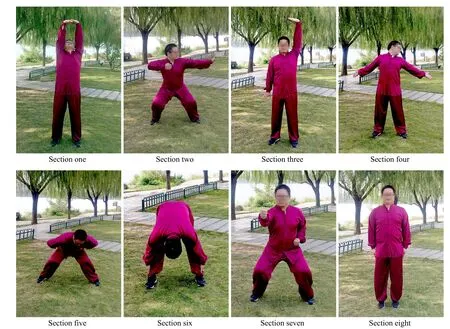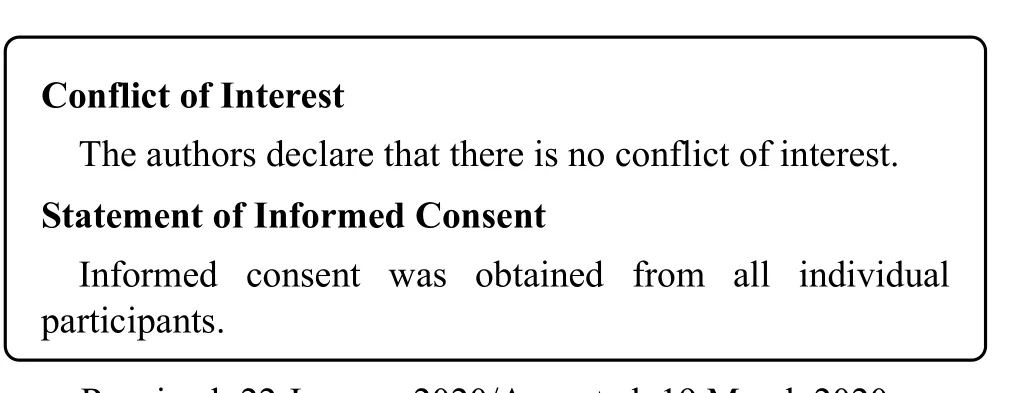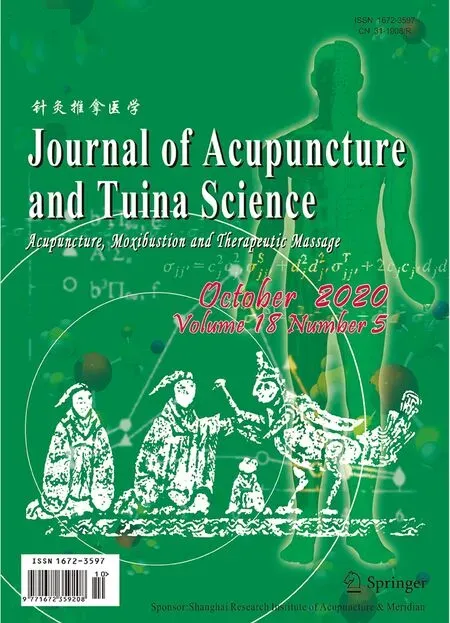Clinical observation of acupuncture and traction plus Ba Duan Jin (Eight-brocade Exercise) for improving discogenic low back pain
Sheng Shao-liang (盛绍良)
TiantaiHospital of Traditional ChineseMedicine,Zhejiang 317200,China
Abstract
Keywords: Acupuncture Therapy; Traction; Ba Duan Jin; Physical and Breathing Exercises; Intervertebral Disc; Low Back Pain; Visual Analog Scale; Pain Measurement
In recent years, discogenic low back pain (DLBP) has attracted more and more attention. It is a common type of low back pain and is more likely to affect m iddle-aged people at ages 35-55,while elderly people over 60 years old have a lower incidence rate[1]. In absence of symptoms caused by nerve root compression and imaging evidence of over-dislocated vertebral body,DLBP is often caused by intra-disc nociceptors stimulated by degenerated disc, ruptured annulus and disc inflammation, etc. Most typically, people w ith DLBP are not able to sit or stand for a long time,w ith restricted motion when turning, which greatly affects the daily life and work.Treatment of DLBP can be divided into two major methods:surgical and non-surgical treatments. There exist disadvantages such as a high relapse rate and complications w ith surgical treatment. Therefore,non-surgical treatment ismore popular in clinical practice[2].In this case,this trial adopted acupuncture and traction plus Ba Duan Jin(Eight-brocade Exercise)to treat DLBP and achieved significant efficacy.
1 Clinical Materials
1.1 Diagnostic criteria
By referring the clinical diagnostic criteria for DLBP in theOverview of the Diagnosis of Discogenic Low Back Pain[3]:recurrent low back and lower-limb pain,unrelated to the nerve root; low signal in the affected intervertebral disc on T2-weighted MRI image; positive discography, contrasted by the negative manifestation in the adjacent segments; zygapophyseal joint blocking ruled out pain due to degenerative zygapophyseal joint.
1.2 Inclusion criteria
Conformed to the clinical diagnostic criteria for DLBP;abnormal signs of lumbar spine ruled out by X-ray exam ination and lumber intervertebral disc herniation ruled out by lumbosacral MRI;in absence of severe diseases involving other systems;not using other treatments; informed consent form signed before the beginning of treatment.
1.3 Exclusion criteria
Unable to complete the practice of Ba Duan Jin(Eight-brocade Exercise)due to a poor body constitution;coupled w ith lumbar nerve root compression;failed to finish the whole treatment course.
1.4 Statistical methods
The SPSS 22.0 statistical software was used for data analyses.The measurement data w ith normal distribution and homogeneity of variance were expressed as mean± standard deviation(±s),exam ined using pairedt-test in intra-group comparisons and independent samplet-test in between-group comparisons.The data of disease duration were expressed as mean (interquartile range) [M (IQR)] and exam ined using nonparametric test. Chi-square test was adopted for comparisons of rate.P<0.05 indicated that the difference was statistical significance.
1.5 General data
A total of 60 patients were enrolled in this trial between January 2016 and December 2017 from the Acupuncture-moxibustion Department of Tiantai Hospital of Traditional Chinese Medicine. They were divided into an observation group and a control group by the random number table method, with 30 cases in each group. There were no dropout cases in the two groups during intervention.
In the observation group, the patients' age ranged from 21 to 68 years old and the disease duration ranged from 1 month to 10 months. In the control group, the patients' age ranged from 18 to 65 years old and the disease duration ranged from 1 month to 12 months.There were no significant differences in the data of gender,age and disease duration between the two groups, suggesting the comparability (Table 1).

Table 1. Com parison of the general data between the two groups
2 Treatment Methods
2.1 Control group
2.1.1 Acupuncture treatment
Acupoints:Ashi points,Mingmen(GV 4),Yaoyangguan(GV 3),Shenshu(BL 23),Dachangshu(BL 25), Ciliao (BL 32) and Weizhong (BL 40).
Method: Hwato Brand disposable sterile acupuncture needles (0.30 mm in diameter and 50 mm in length)were used.All the acupoints were inserted perpendicularly for 1.0-1.2 cun.The needles were retained for 20 m in after the needling qi was obtained.The treatment was given once a day, one week as one course, w ith a 3-day interval between 2 courses, for a total of 4 courses.
2.1.2 Traction
The lumbar traction was applied w ith 40%-50% body weight,30 m in per time, once a day, for a total of 30 times.
2.2 Observation group
The observation group practiced Ba Duan Jin(Eight-brocade Exercise) in addition to the acupuncture and traction treatment given to the control group.
The patients were taught by professionals how to master the essentials before they started to practice Ba Duan Jin(Eight-brocade Exercise),which consists of eight sections (health maintenance qigong reorganized by the General Adm inistration of Sport of China in 2003), (Figure 1).
Section one is holding up the hands to regulate the three Jiao (triple energizer).Key points:raise up the hands above the head, open the chest and stretch the body, and look upward at the hands, turning the palms upward when the hands pass by the chest.When stretching the body, keep the chin tucked in and the neck long and straight upward. Hold it for a few seconds,during which the spine exerts an opposing force to pull towards two ends while the up-going force should reach to the palms. When dropping down the hands,relax the low back, drop the hips, shoulders and elbows,relax the w rists and fingers, and keep the upper body in a neutral position.
Section two is draw ing a bow like shooting a hawk.Key points: firstly, cross the w rists in front of the chest while paying attention to drop the shoulders and elbows and not let the palms go above the level of the shoulder. Open the arms and pull as if drawing a bow,open the chest and shoulders, extend the w rist and erect the fingers, and turn the head fully. The fingers of the pulling hand should clench together, w ith the arm and the chest at the same level, while the other hand form a ‘八' like palm, w ith the w rist and fingers erected and palm hollow. Hold the motion for 2 s, stretching as if draw ing a bow to shoot a hawk.
Section three is raising one arm to regulate the spleen and stomach. Key points: raise up one arm and press down the other, w ith the force reaching to the root of the palms, expanding the chest and stretching the body to extend the spine, as if supporting between the sky and earth.
Section four is turning the head back to treat consumptive diseases and injuries.Key points:press down w ith the palms while keeping the spine and neck straight. Then fully rotate the arms outward, extend the shoulders and keep the head up. Try not to turn the body while turning the head back.
Section five is swaying the head and sw inging the buttocks to expel the heart-fire. Key points: keep the nape and spine straight when going down in a horse standing, w ith the hips and buttocks tucked in and the upper body in the neutral position; pulling the neck and tailbone in the opposite directions when bow ing down to the sides; keep the neck relaxed when swaying the head, w ith motions in a gentle and slow manner, and try to be in fluidity when sw inging the buttocks.
Section six is holding the feet by the hands to reinforce the loins and kidney. Key points: bend forward asmoving the hands down the outside of the body from below the armpits, during which the spine relaxes little by little, and drop the shoulders when reaching the feet;before unbending,support the hands on the ground to stretch the spine, and then lift up the arms to unbend the upper body.
Section seven is punching with angry gaze. Key points:keep the body straight as squatting in a horse stance,and pay attention to adjust the stance based on the strength of the legs; extend the fists alternately w ith intense gaze, while grasping the ground firm ly w ith the toes, turn the waist and extent the shoulders while extending the arms to make the force move till the fists,then fully rotate the w rists and grasp w ith the five fingers forcefully.
Section eight is bouncing on the toes to help prevent diseases.Key points:as lifting up the heels,slow ly stretch the spine, grasp the ground w ith the toes, put the legs together, lift the anus and tuck the abdomen,keep head up, and then hold for a few seconds while keeping in balance; gently bounce on the toes, while keeping the body relaxed and clenching the teeth, and pay attention to drop the shoulders while dropping down the heels.
The exercise was practiced 5 d each week, tw ice a day,30 m in each session.
3 Observation of Therapeutic Efficacy
3.1 Observation items
The visual analog scale(VAS)[4]and Oswestry disability index (ODI)[5-7]were scored before and after treatment.
3.1.1 VAS score
VAS was used to evaluate the pain intensity. Drew a 10 cm straight line on a piece of paper w ith one end marked‘0'to indicate no pain and the other end marked‘10'to indicate the most severe pain.The patient would mark at an appropriate point on his own to represent the pain degree. The number at this point would be the VAS score of the patient.
3.1.2 ODI score
ODI consists of 9 items in total and each item is scored at a 6-point scale by the severity. From mild to severe, it would be scored 0, 1, 2, 3, 4, and 5 points. A higher score suggests more serious dysfunction.
3.2 Criteria for therapeutic efficacy
The efficacy criteria were made based on theCriteria of Diagnosis and Therapeutic Effects of Diseases and Syndromes in Traditional Chinese Medicine[8].
Recovered:The movement of the low back was normal, the tenderness and pain in the low back was gone and would not be triggered by fatigue; no relapse in 3 months after treatment.
Markedly effective:Low back tenderness and pain were substantially gone, with occasional discom fort in the low back after movements.
Improved:Low back pain and tenderness reduced notably and basic movements of the low back were possible.
Invalid: Low back pain and tenderness were still there and there was no improvement w ith the lim ited motion of the low back.
3.3 Results
3.3.1 Comparison of the clinical efficacy
After treatment, the total effective rate was 96.7% in the observation group versus 83.3%in the control group,and the between-group difference was statistically significant (P<0.05), (Table 2).

Figure 1.Illustration of the motions of Ba Duan Jin (Eight-brocade Exercise)

Table 2.Com parison of the clinical efficacy between the two groups (case)
3.3.2 Comparison of the VAS score
There was no significant difference in the VAS score between the two groups before treatment (P>0.05).The VAS score dropped markedly after treatment in both groups and the intra-group differences were statistically significant (bothP<0.05).After treatment,the VAS scorewas lower in the observation group than in the controlgroup and the between-group difference wasstatistically significant (P<0.05),(Table 3).difference was statistically significant (P<0.05), (Table 4).3.3.4 Comparison of the relapse rate
Table 3. Comparison of the VASscore before and after treatment (±s, point)

Table 3. Comparison of the VASscore before and after treatment (±s, point)
Group n Pre-treatment Post-treatment t-value P-value Observation 30 7.60±1.19 1.80±1.19 5.124 0.001 Control 30 7.93±1.11 2.93±1.55 4.763 0.001 t-value 1.120 3.178 P-value 0.267 0.002
At the 6-month follow-up, there were 3 relapse cases and the relapse rate was 10.3%(3/29)in the observation group, versus 12 relapse cases and 48.0%(12/25)in the control group.The between-group difference in the relapse rate was statistically significant (χ2=6.127,P=0.003).
Table 4. Com parison of the ODI score ( ±s, point)

Table 4. Com parison of the ODI score ( ±s, point)
Group n Pre-treatment Post-treatment t-value P-value Observation 30 36.90±3.78 12.50±3.98 6.731 0.001 Control 30 38.47±3.40 17.73±7.53 5.985 0.001 t-value 1.652 3.366 P-value 0.104 0.002
3.3.3 Comparison of the ODI score
There was no significant difference in the ODI score between the two groups before treatment (P>0.05).After treatment, the ODI score dropped significantly in both groups and the intra-group differences were statistically significant (bothP<0.05). The ODI score was lower in the observation group than in the control group after treatment and the between-group
4 Discussion
DLBP belongs to the scope of Bi-impediment syndrome in traditional Chinese medicine (TCM), often caused by traumas,strains and cold-dampness,involving pathological changes in qi and blood,meridians and Zang-fu organs[9-10],consequently resulting in pain due to blocked meridians in the low back[11].
Numerous scholars have put forward various hypotheses, such as nerve root decompression theory,adhesion release theory and balance adjustment theory[12].DLBP,also named lumbar internal disc derangement, usually happens after significant injuries in the low back,presenting one or multiple internal structural and functional abnormalities. After a lumbar disc injury, the annulus ruptures and releases some factors, stimulating the cartilaginous endplate and the distributed nerves in the annulus, subsequently leading to pain, especially when the low back is loaded with increasing pressure.DLBP clinically manifests as intensive pain and lim ited lumbar motion after long-time sitting. So far, this disease is majorly treated w ith conservative interventions[13],such as drugs,acupuncture-moxibustion,traction,tuina,physiotherapy and functional exercises, to m itigate the pain.Among the interventions,functional exercises can increase the strength of the back muscles to protect the injured disc at the same time of releasing pain, and thus has been universally considered as the most effective method in treating DLBP. Through stimulating acupoints,acupuncture can boost the brain cells to produce endorphin to enhance the pain threshold of topical tissues and soothe the cramping muscles,so as to produce its analgesic effect. In this trial, Shenshu (BL 23)and Weizhong (BL 40)were selected since they can reinforce the kidney and strengthen the low back and are effective points for low back pain.Yaoyangguan(GV 3) can warm and nourish the prenatal yang qi[14].Traction works to correct the facet joint disorder and restore the normal spinal curvature and motions via improving spinal deform ity[15-18].Therefore,acupuncture, traction and functional exercises are often used together in clinical practice.
Of all the functional exercises,Ba Duan Jin(Eight-brocade Exercise) is a form of health qigong and quite popular in China[19]. Its movements are simple but gentle in fluidity,combining both the relaxation and tightness,dynam ics and statics[20-21].Taking the low back as the axis, Ba Duan Jin (Eight-brocade Exercise)works to strengthen the tendons and bones,supplement qi and activate blood flow, and harmonize the functions of Zang-fu organs[22]. Moreover, through active movements of the limbs and spine, this exercise can promote the nervous nutrition and blood circulation in the whole body and rhythm ically pull the relevant nerves and muscles to help mitigate the cramping muscles and reduce pain[23]. Acupuncture and traction are indeed effective in treating DLBP, but the high relapse rate is a concern. When combined with Ba Duan Jin(Eight-brocade Exercise),it can not only enhance the clinical efficacy,but also significantly improve the activities of daily living, so as to prevent the flare-up of the disease[24].
The results demonstrated that the VAS and ODI scores were significantly lower in the observation group than in the control group after treatment,and the relapse rate at the 6-month follow-up was also markedly lower in the observation group (allP<0.05),suggesting that acupuncture and traction plus Ba Duan Jin (Eight-brocade Exercise) is effective for DLBP, w ith a satisfactory long-term efficacy, better than acupuncture and traction, and thus is worth promoting.

C onflict of Interest The authors declare that there isno conflict of interest.Statement of Informed Consent Informed consent was obtained from all individual participants.
Received:22 January 2020/Accepted:19March 2020
 Journal of Acupuncture and Tuina Science2020年5期
Journal of Acupuncture and Tuina Science2020年5期
- Journal of Acupuncture and Tuina Science的其它文章
- Clinical observation on electroacupuncture plus Yi Jin Jing (Sinew-transform ing Qigong Exercises) for knee osteoarthritis
- Clinical efficacy comparison of moxibustion w ith different doses for knee osteoarthritis
- Clinical observation on acupoint injection for back pain in patients w ith primary osteoporosis
- Clinical observation on Yi Jin Jing(Sinew-transform ing Qigong Exercises) plus tuina on the neck for stiff neck
- Efficacy evaluation of acupuncture plus rehabilitation training for post-stroke deglutition disorders of qi-deficiency blood stasis pattern
- Clinical observation of acupuncture plus Frenkel exercises for ataxia after cerebral stroke
